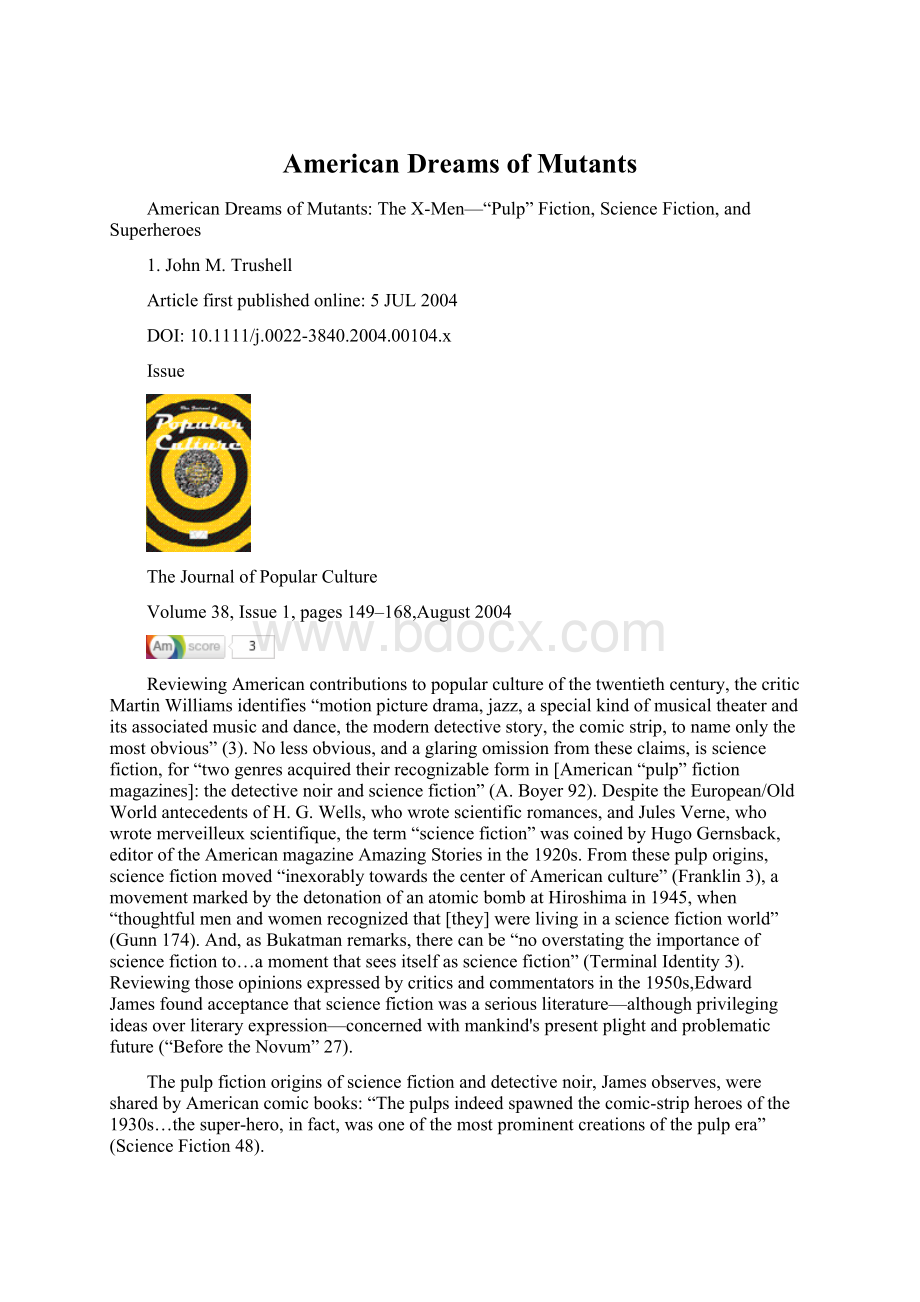American Dreams of Mutants.docx
《American Dreams of Mutants.docx》由会员分享,可在线阅读,更多相关《American Dreams of Mutants.docx(10页珍藏版)》请在冰豆网上搜索。

AmericanDreamsofMutants
AmericanDreamsofMutants:
TheX-Men—“Pulp”Fiction,ScienceFiction,andSuperheroes
1.JohnM.Trushell
Articlefirstpublishedonline:
5JUL2004
DOI:
10.1111/j.0022-3840.2004.00104.x
Issue
TheJournalofPopularCulture
Volume38, Issue1, pages149–168,August2004
Reviewing Americancontributionstopopularcultureofthe twentiethcentury,thecriticMartin Williams identifies“motionpicturedrama,jazz,aspecialkindofmusicaltheateranditsassociatedmusicanddance,themoderndetectivestory,thecomicstrip,tonameonlythemostobvious”(3).Nolessobvious,andaglaringomissionfromtheseclaims,issciencefiction,for“twogenresacquiredtheirrecognizableformin[American“pulp”fictionmagazines]:
thedetectivenoirandsciencefiction”(A.Boyer 92).DespitetheEuropean/OldWorldantecedentsofH.G.Wells,whowrotescientificromances,andJulesVerne,whowrote merveilleuxscientifique,theterm“sciencefiction”wascoinedbyHugoGernsback,editoroftheAmericanmagazine AmazingStories inthe1920s.Fromthesepulporigins,sciencefictionmoved“inexorablytowardsthecenterofAmericanculture”(Franklin 3),amovementmarkedbythedetonationofanatomicbombatHiroshimain1945,when“thoughtfulmenandwomenrecognizedthat[they]werelivinginasciencefictionworld”(Gunn 174).And,as Bukatman remarks,therecanbe“nooverstatingtheimportanceofsciencefictionto…amomentthatseesitselfassciencefiction”(TerminalIdentity 3).Reviewingthoseopinionsexpressedbycriticsandcommentatorsinthe1950s,EdwardJames foundacceptancethatsciencefictionwasaseriousliterature—althoughprivilegingideasoverliteraryexpression—concernedwithmankind'spresentplightandproblematicfuture(“BeforetheNovum”27).
Thepulpfictionoriginsofsciencefictionanddetectivenoir, James observes,weresharedbyAmericancomicbooks:
“Thepulpsindeedspawnedthecomic-stripheroesofthe1930s…thesuper-hero,infact,wasoneofthemostprominentcreationsofthepulpera”(ScienceFiction 48).
Thepulpsofthe1930sfeaturedsuch“menofmystery”asDocSavage,“TheManofBronze,”andhisFabulousFive(DocSavageMagazine#1:
March1933),and“TheSpider,”acapedvigilante(TheSpider#1:
October1933),1 whilethecomicsintroducedSuperman,“TheManofSteel”(ActionComics#1:
June1938),andBatman,“TheCapedCrusader”(DetectiveComics#27:
May1939).ThedebutsofSupermanandBatman,themoresuccessfulandenduringsuperheroes,werefollowedbythoseofTheHumanTorchandNamortheSub-mariner(MarvelComics#1:
October/November1939)toestablisha“goldenage”ofcomics.Thesesuperherostories—produced, Bukatman alleges,“largelybyyoungmalesforsomewhatyoungermales”(“X-bodies”95)—havebeenconsideredtobesciencefictionalbeit,as Jamescontends,“shornofallsophistication”(ScienceFiction 83).Butthesestoriesaremoreproperlyfantasies;thesuperheroesretainedthemysticismoftheirpulppredecessors(LangandTrimble 165)and,althoughsetinplausibleworldswhereeven“theirrationalorthestrangeisstillexplicableinquasi-scientificoreverydayterms”(Abercrombie,Lash,andLonghurst 123),superherostoriesusedscienceas“analibiformagic”(Reynolds 53).Bothsciencefictionandfantasyare estrangedgenres—possessingan“imaginativeframeworkalternativetotheauthor'sempiricalframework”(Suvin 60–61)—asopposedtonaturalisticgenres(Parrinder 37),butseparatedbythenotionof cognition inherentin“theGernsbackianideaoffictionwithascientificexplanation”(Parrinder 37).
The1920sand1930switnessedtheriseoftheAmericansciencefictionshortstory,butthe1940ssawthesciencefictionstoryhonedbywriterschosenbyeditorJohnW.Campbellforpublicationin AstoundingScienceFiction.Sciencefictionbeganappearingin“mass-circulationmagazineslike Collier's andthe SaturdayEveningPost”(P.Boyer 257),butmanygeneralreaderscontinuedtoconsidersciencefictionasescapistorunrealistic,whichcontributedtoa“ghetto”mentalityamongfans.This“ghettoizing”ofsciencefictionwasnotentirelyimposedfromwithout;manysciencefictionwritersandreadersregarded“thebulkoftheirownsocietyasmistaken,ill-informed,andprobablyineducable”(Shippey 101).Nevertheless,the1950ssaw“theemergenceofsciencefictionfromitsparaliteraryghetto”(A.Boyer 96)withthepublicationofsociallyconsciousandcriticalstoriesandnovels.Yet,thisseriousandsophisticatedliteraturecoexistedwithunsophisticatedparaliterature,suchasarticlesandstoriesthatencourageda“cultofirrationalityandUFOism”(Seed 9).ThesestorieswerepublishedaftertheSecondWorldWarbyRayPalmer,whosucceededGernsbackastheeditorof AmazingStories.Serioussciencefictionsurvivedthecrashofsciencefictionmagazines(whichdwindledfromfortytoameresixorseveninthelate1950s[Sadoul 217],dueinparttothefailureofthemajormagazinedistributorAmericanNewsCompany),thedeclineofmass-circulationmagazinessuchas Collier's,andtheriseoftelevision.
Unsophisticatedsuperherocomics,bycontrast,flourishedforthegoldenagebeforeandduringtheSecondWorldWar.TheAxisthreatwascounteredbyarosterofpatrioticsuperheroes—includingCaptainAmerica,theEagle,theShield,theStar-SpangledKidandStripesy,andUncleSam—whoprovided“fantasiesofsuperhumanpower[overcoming]thedevastatinglydehumanizingforcesassociatedwithFascism”(Schmitt 155).Butthisgoldenageendedin1954withthepublicationofFredericWertham's SeductionoftheInnocent,“397impassionedpagesdetailingtheperniciouseffects”ofcomics(Ross 110).Americancomicbooksweresubjectedtoascarecampaign,oneofthose“moralcrusadesoftheMcCarthyera”(Brown 18)thattapped“thegeneralculturalparanoiaoftheperiodthroughthecontinualandeffectiveuseofthepopularpress”(Parsons 71).Althoughthis“comicscare”undoubtedlydamagedthecomictrade,televisionhadcontributedtothedeclineofcomicsalesby“siphoningoffthecomicbookaudience”(Parsons 72)withprogramssuchas CaptainVideo (1949–53), TomCorbett,SpaceCadet(1950–54),and SpacePatrol (1950–56).Comicbookpublishers,“toescapethewitchhuntswithwhatlittleaudiencetheyhadleft”(Brown 21),submittedto“abusybodyreviewboardandaninsufferablecodethatamountedtotheemasculationofcomicbooks”(Richler 306).
However,SupermanandBatmansurvivedthe1950s,reconcilingthemselvestotherequirementsofthepost-WerthamComicsCode.Supermanwaseventranslatedsuccessfullyfortelevisionin TheAdventuresofSuperman (1953–57).Furthergoldenagesuperheroeswererehabilitatedorreoriginated.ThefirstwastheFlash(Showcase#4:
October1956),fromwhoseappearancethe“silverage”ofcomicsisdated(McCue 35–38; Reynolds 9).ButtherevitalizationofAmericancomicbookshasbeenattributedtothedebuts,intheearly1960s,ofnewheroessuchastheFantasticFour(FantasticFour#1:
November1961),Spider-Man(AmazingFantasy#15:
August1962)andtheX-Men(TheX-Men#1:
September1963).ThesewereproductsoftheMarvelComicsGrouphelmedby StanLee.2
MarveloftheSilverAge
MordecaiRichlerobservesthatthegoldenagesuperheroeshadconstituted“invulnerable,all-conquering”championsforchildren,providing“revengefiguresagainstwhatseemedagratuitouslycrueladultworld”(306,300).TherelevanceofthesesuperheroesforchildrenwasepitomizedbyayoungBillyBatsonwho,uponutteringthemagicword“SHAZAM”(anacronymofSolomon,Hercules,Atlas,Zeus,Achilles,andMercury),wastransformedintotheworld'smightiestmaturemortal,CaptainMarvel(WhizComics#2:
February1940),“anallegoryofpubescentmetamorphosis,”alleges Bukatman (“X-bodies”100).Suchgoldenagesuperheroes“werealwaysadults,exceptwhenfollowedbyaxeroxedsidekick”(McCue 41);BatmanwasfollowedbyRobin(DetectiveComics#38:
April1940)andTheHumanTorchbyToro(TheHumanTorchComic#2:
Fall1940).Thesesidekickshadserved“asasourceofidentificationforyoungadolescents”(Brody 176).MarvelComics'innovationwasto“pioneercomicsfortheadolescent”(JacobsandJones 129)thatdealtwith“titanicbattlesbetween[teenagedsuperheroes]andmiddle-agedsupervillains”(Mondello 233).
NumberedamongtheFantasticFour,whowereexposedtocosmicraysinanear-earthorbitingspacecraftandtransformedintosuperheroes,wasanewHumanTorchwhocouldburstintoflameswithoutbeingconsumedbyfire.TheTorchwasanimpulsive,literallyhot-headedhighschoolstudentwithapenchantforhot-rods.Thewise-crackingSpider-Man,whosesuperhumanpowerswereacquiredbythebiteofaradioactivespiderwhilevisitingascienceexhibition,wasahighschoolbookwormwho, Bukatman observes,hadacertain“nerdycharm”(“X-bodies”95)andlivedwithhiswidowedaunt.TherewasamutualantagonismbetweenthesilverageHumanTorchandSpider-Man,begunwhenSpider-MancrashedapartyheldbytheHumanTorch'sgirlfriend(TheAmazingSpider-Man#8:
January1964).Thiscontributedtothecrossoversalesofbothcomicbooktitles.
Thesemid-1960ssuperheroesweretornbetweenapreferenceforself-gratification—theTorchwasagirl-chaserandSpider-Manwas“neuroticallyobsessedwithstatusandworldlysuccess”(LangandTrimble 165)—andpublicservice(Mondello 235; SkidmoreandSkidmore 89).Oftenperceivedasamenacetosociety,theseteenagedsuperheroesconsequentlyfelt“ambivalencetowardsocietyandtheirplaceinit”(LangandTrimble 167),anallegoryofadolescentanomie.
TheX-Men,however,wereadifferentproposition.Theseteenagerswere,asthecomicbookcoverproclaimed,“TheStrangestSuper-HeroesofAll.”Cri